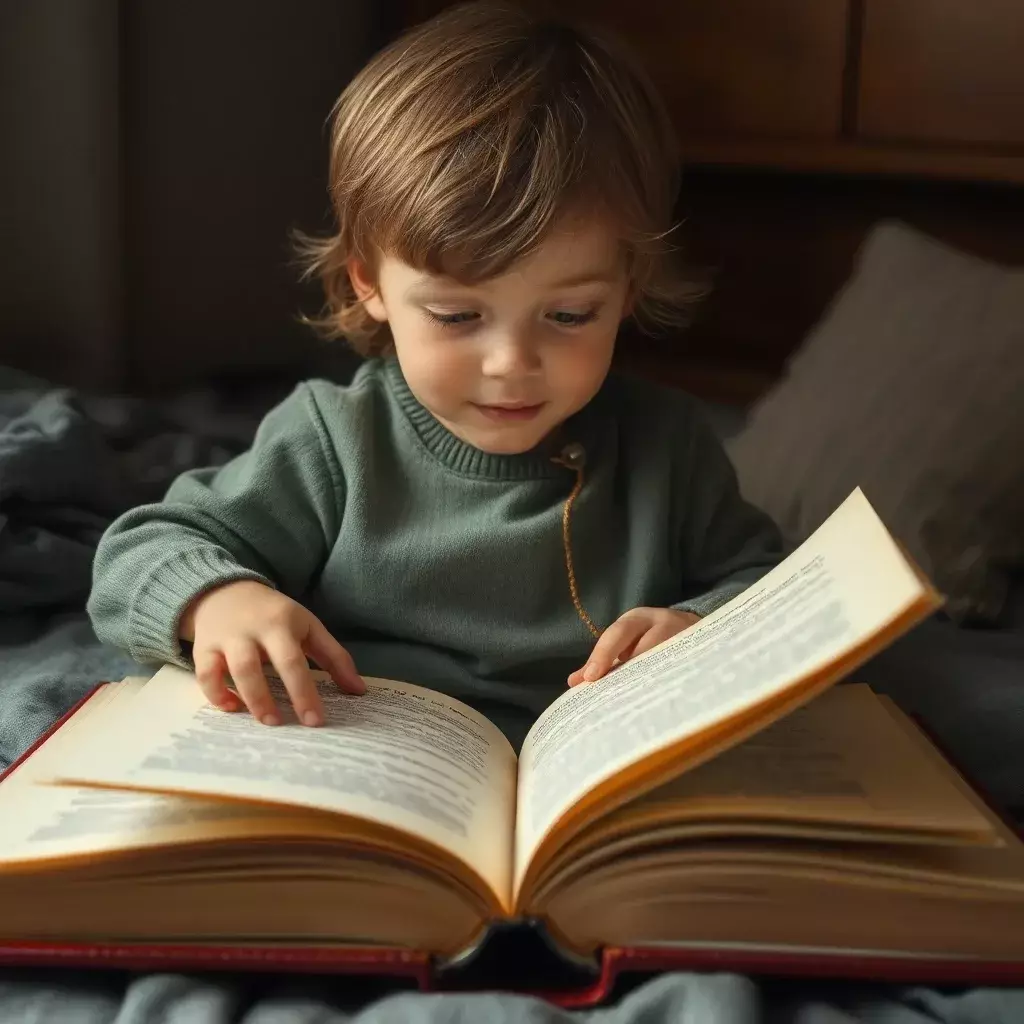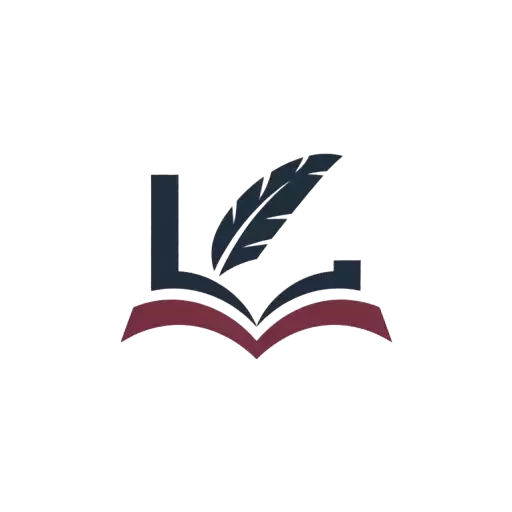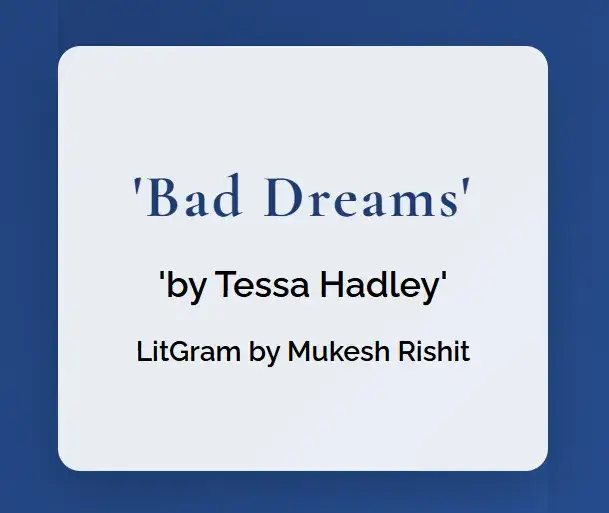Have you ever woken up from a dream so vivid, so disorienting, that it seemed to seep into your waking life? Maybe it wasn’t just the dream that shook you, but the fragile way it blurred the lines between your subconscious and reality. Welcome to the world of Tessa Hadley’s “Bad Dreams”.
This short story is more than just a narrative—it’s a journey into the murky realm of dreams, memory, and the silent truths embedded in our lives. Tessa Hadley takes what feels like an intimate, ordinary slice of family life and spins it into a haunting exploration of our inner worlds.
Relevance
In our hyper-connected age, the quiet tension of “Bad Dreams” feels like a meditation on the power of the subconscious. It pulls us away from the noise and asks us to consider how the smallest moments—actions, words, even dreams—can carry ripple effects we never anticipate.
Promise
Through this blog post, we’ll dig into the layers of “Bad Dreams”, unpacking its delicate symbolism and nuanced narrative. Whether you’re a fan of literary fiction, a dream enthusiast, or someone who loves uncovering the inner workings of family dynamics, this analysis promises to leave you thinking about your own bad dreams and what they might reveal about your waking life.
The Power of Childhood Imagination
Childhood is often a fertile ground for creativity, but it’s also where the lines between fantasy and reality become the blurriest. Hadley’s young protagonist exemplifies how a child’s mind processes the world: through heightened imagination and sensory perception.
In “Bad Dreams”, we see a child venture out of bed at night, setting off a chain of events that feels both deeply innocent and eerily foreboding. Children, after all, are masters of creating stories to fill gaps they can’t yet rationalize. The nighttime wandering feels less like mischief and more like an echo of the subconscious mind trying to make sense of the adult world.
Did You Know?
According to child psychologists, young children often have difficulty separating dreams from reality. Their vivid imaginations can even influence their waking perceptions. This power of imagination is at the heart of the protagonist’s small yet impactful adventure.
The Ripple Effect of Small Actions
Hadley’s storytelling magic lies in her ability to turn microscopic moments into seismic events. The child’s small action—tearing pages out of a book—may seem trivial at first. However, as we turn the pages, the ripple effect becomes undeniably profound.
This brings to mind the “butterfly effect,” a concept from chaos theory stating that small actions can lead to massive consequences. The child’s nighttime journey doesn’t just disturb the family order—it metaphorically shakes the foundation of the household.

Visualize It
Imagine an infographic titled “The Domino Effect of a Bad Dream”. At the root? A small act of nighttime curiosity. The final domino? Revelations that unearth familial tensions long buried under the surface.
Family Dynamics and Unspoken Tensions
Though Hadley’s prose feels light and subtle, the undercurrent of family unease in “Bad Dreams” runs deep. The family interactions in the story—and the revelations brought to light—underscore one critical truth: what we leave unsaid often speaks volumes.
The dream, or rather, the child’s interpretation of it, acts as a kind of Freudian mirror. It reflects the unspoken resentments, fears, and complexities dividing even those closest to one another. It’s a reminder that families, though bound by love, often carry tensions that go unvoiced for years.
Pro Tip for Readers
Pay close attention to the seemingly mundane dialogues and actions of the adult characters in the story. These moments are loaded with subtext, offering a window into deeper, unresolved conflicts.
The Thin Line Between Dreams and Reality
If you’ve ever woken up from a dream unsure if it really happened, Tessa Hadley knows how you feel. She brilliantly blurs the line between dreams and reality, weaving a narrative where the boundaries feel almost nonexistent.
Dreams can feel real because they borrow from our lived experiences, refracting them through emotions and fears stored deep in the subconscious. In “Bad Dreams”, the dreamworld feels like an extension of the waking one—a hazy lens through which the characters’ inner truths come into focus.
Expert Quote:
Dr. Matthew Walker, a renowned sleep neuroscientist, once explained that “dreams can act as therapy, allowing us, in symbolic ways, to process our emotional fears and experiences from real life.” This interconnection perfectly complements Hadley’s exploration of dreams as catalysts for reckoning with reality.
Symbolism and Hidden Meanings
Hadley’s “Bad Dreams” thrives on layers of meaning, and part of the joy in reading it comes from deciphering its symbols. What does the torn book represent? Perhaps it’s a metaphor for the fragility of the stories we tell ourselves—or the inability to rewrite them.
Other symbols, like the vase and the darkened family home, seem to carry weightier implications about transience, restraint, and the suffocating stillness often embedded in family life. Readers are invited to interpret these symbolic layers in ways that resonate most deeply with their own experiences.
Interactive Ask
What do you think the torn book symbolizes in the story? Drop your interpretation in the comments below—there are no wrong answers here!
The Art of the Short Story
Short stories are often overlooked in favor of longer works, but Hadley demonstrates the immense power and precision of this literary form. Everything in “Bad Dreams” feels intentional—even the smallest details possess gravity.
In fact, the brevity of the story leaves no room for fillers, heightening its sense of immediacy. Compared to sprawling novels that set a leisurely pace, short stories like Hadley’s offer readers the kind of tightly woven narrative that lingers long after the last word.
Did You Know?
Short stories have a storied history of tackling big ideas in small packages. From Edgar Allan Poe’s gothic tales to Alice Munro’s award-winning works, this format excels in exploring universal truths with laser-sharp focus.
Interactive and Visual Add-Ons
Custom Infographic Idea:
“The Anatomy of a Bad Dream”
- Core Components: Childhood imagination, the ripple effect, tension, and resolution.
- Visually break down the story’s pivotal moments and how they connect under the “dream” motif.
Interactive Poll:
“Have you ever had a dream so realistic it changed how you felt about real-life circumstances? Yes or No?”
Practical Takeaways
- Dream Interpretation Tips: Keep a journal by your bed and jot down vivid dreams upon waking to better understand your subconscious.
- Writing Practice: Use your most memorable dreams as story prompts—Tessa Hadley transformed one into a stunning short story, and so can you!
- Families and Fiction: Stories like “Bad Dreams” are excellent discussion starters about unspoken family dynamics. Try using fiction to explore those tricky conversations.
Conclusion: Dreams That Shape Us
Tessa Hadley’s “Bad Dreams” plants itself in the fertile ground where dreams, reality, and memory overlap. Its haunting simplicity is a testament to the power of the subconscious and a reminder that even our smallest actions can ripple outward in unexpected—and often unsettling—ways.
Whether through its vivid symbols, blurred realities, or unearthing of family tensions, this story sticks to you like a dream you just can’t shake. After all, what are dreams but another way of coming to terms with who we are and how we see the world around us?
Let’s keep the conversation going—what’s the most memorable “bad dream” you’ve ever had? Share your stories below. Who knows? Maybe your dream holds the next great literary inspiration.
FAQs
1. What is the main theme of Tessa Hadley’s “Bad Dreams”?
The story examines themes like the power of the subconscious, family dynamics, hidden tensions, and the blurred line between dreams and waking reality.
2. How does the short story format enhance “Bad Dreams”’ impact?
The brevity makes every word intentional, creating a taut and focused narrative that resonates deeply with readers.
3. What does the torn book symbolize in the story?
While open to interpretation, it may represent the fragility of family stories, the impossibility of rewriting the past, or suppressed tensions tearing through the surface.
4. Why does Hadley use dreams as a central motif?
Dreams allow her to explore subconscious truths, emotional fears, and hidden desires, offering a symbolic lens to examine the characters’ lives.
5. Can literature like “Bad Dreams” help us explore personal family issues?
Absolutely! Fiction often mirrors real-life complexities, providing a safe platform for readers to reflect on and even discuss difficult subjects.


